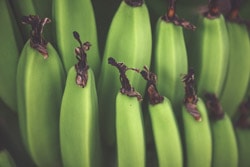Plantain

About Plantain
- Plantain is a member of the Musaceae botanical family, which also includes banana. Unlike bananas, plantains are not sweet and are typically cooked prior to eating.
- Plantains are common in Latin American and Caribbean cuisines and are commonly described as having a mild squash or potato-like flavor. The taste of plantains depends on their ripeness and how they’re prepared.
- Plantains are an excellent source of vitamin A, vitamin C, vitamin B6 and potassium, making them a great choice for adding variety and nutrients to your diet.
- When purchasing plantains, be aware of their various stages of ripeness:
- Green plantains are firm, starchy and taste similar to a potato.
- Yellow plantains may have some black spots as they ripen. They taste slightly sweet and will continue to have a firm texture.
- Black plantains are at the most ripe stage and start to become less firm. These can be eaten raw, but are still typically cooked in some way. Black plantains are not rotten and there is no need to throw them out.
 Preparing Plantain
Preparing Plantain
- Ripen plantain at room temperature. Once ripe, they can be kept at room temperature, out of the sun, for a couple of days, or stored in the refrigerator for up to one week.
- Plantains can also be frozen for two to three weeks.
- To peel a plantain, cut off both ends, slice through the skin lengthwise, then remove the skin.
- Plantains can be baked, fried, grilled, steamed or boiled. Add them to soups, stews and sauces.
Nutrition Facts
1 cup plantain (boiled and mashed)
Calories: 232 | Protein: 1.58 g | Fat: 0.36 g | Carbohydrate: 62.3 g | Fiber: 4.6 g | Calcium: 4.0 mg | Iron: 1.16 mg | Magnesium: 64 mg | Phosphorus: 65 mg | Folate: 52 μg | Vitamin A: 90 μg
